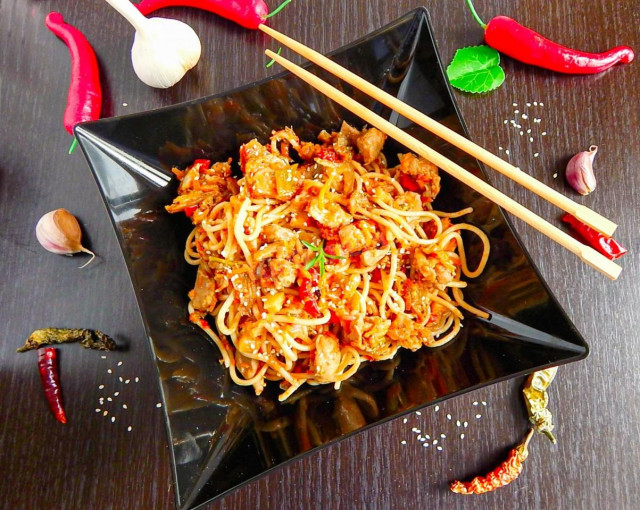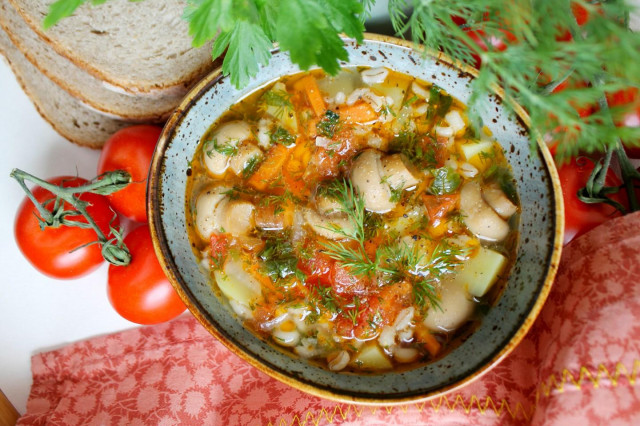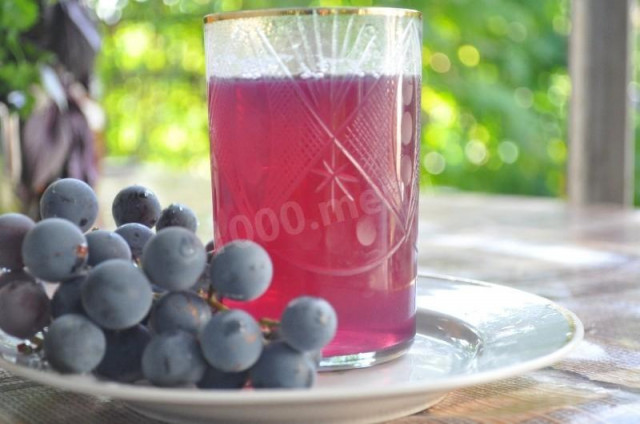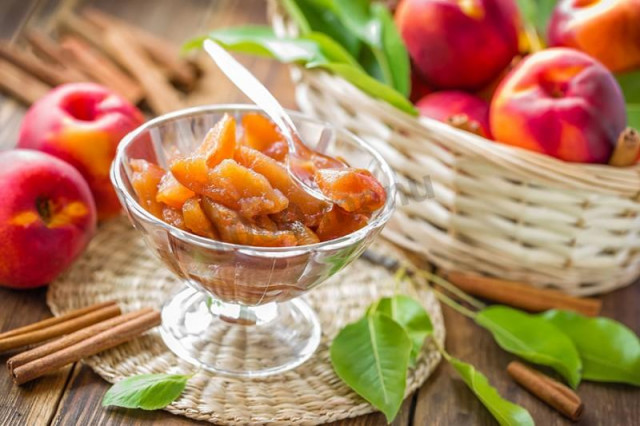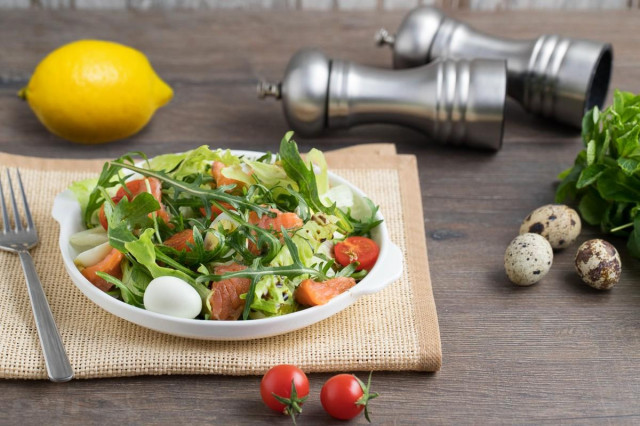Composition / ingredients
Step-by-step cooking
Step 1:
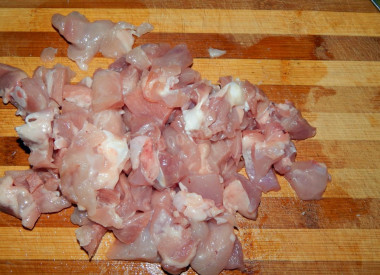
How to make pasta with teriyaki sauce? Prepare the products. Vegetables can be used any to taste and availability. It is easier to use frozen vegetable preparations when the vegetables are pre-washed, cut into cubes or straws and frozen. It remains only to defrost them and throw them into the pan. This will also reduce the cooking time. Wash the meat, dry it and cut into pieces. Fillets can be taken both from the breast and from the hips.
Step 2:
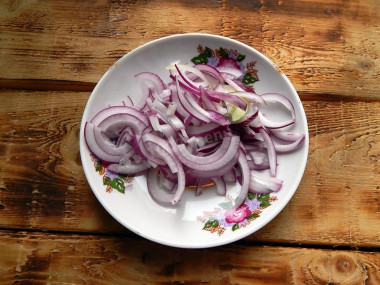
Peel the onion from the husk and cut into cubes or feathers, as you like. Pour vegetable oil into a frying pan, heat it over medium heat and put onions in it. Fry the onion until transparent.
Step 3:

Put the cooked meat in a bowl. Add the spices and pour in one third of the Teriyaki sauce. Stir the meat so that it is completely in the marinade and leave to marinate for 20 minutes. Then send the meat to the frying pan with onions.
Step 4:
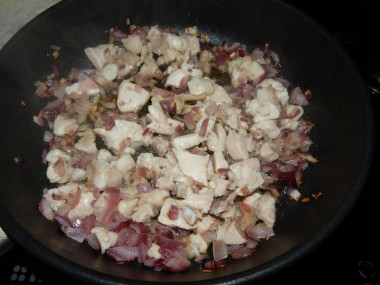
Fry the chicken over high heat, stirring constantly with a spatula, until the meat is browned. Then pour in two-thirds of the remaining amount of Teriyaki sauce. Mix the products.
Step 5:
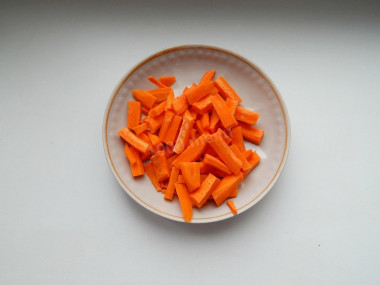
Meanwhile, prepare fresh vegetables. Wash the carrots, peel and cut into strips, cubes or grate on a grater for Korean salads.
Step 6:
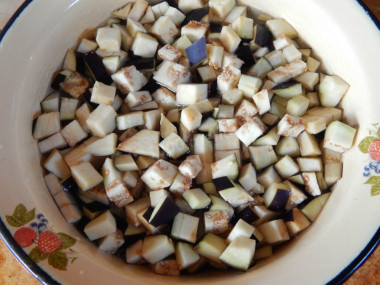
If there are no eggplants, bell peppers and tomatoes in the frozen vegetables, then you can use fresh ones. Wash the eggplants, cut into strips, put the vegetables in a bowl. Add salt and leave for 20 minutes to let the eggplant juice. After the specified time, rinse the eggplants, let the water drain completely. In this way, the specific bitterness of eggplants is removed.
Step 7:

Wash the bell pepper, remove the stalk with the seed capsule, cut the pulp into strips or cubes. Wash the tomatoes, cut out the attachment point of the stalk. Cut the pulp into pieces of any shape. If the skin of the fruit seems rough, then it can be removed by first dipping the tomatoes in boiling water for a few minutes, and then placing them in cold water.
Step 8:
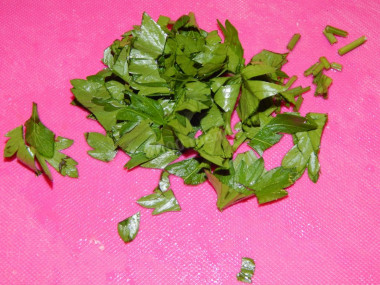
Wash, dry and finely chop the greens.
Step 9:
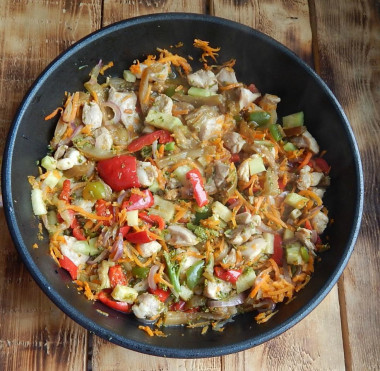
Then send all the cooked vegetables to the meat. Mix it up. Fry on high heat for another 5 minutes. Pour in the remaining sauce. Reduce the heat to medium. Cover and simmer the vegetables with meat for about 10 minutes.
Step 10:
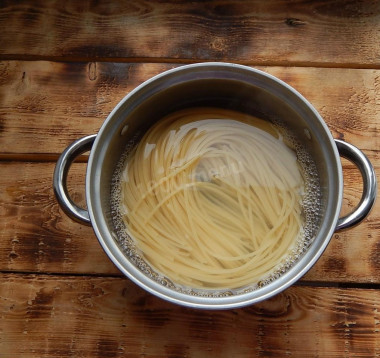
Meanwhile, boil the pasta in boiling salted water for about 7 minutes. Rinse, flip into a colander and transfer to a frying pan with vegetables and meat. Add chopped peeled garlic.
Step 11:
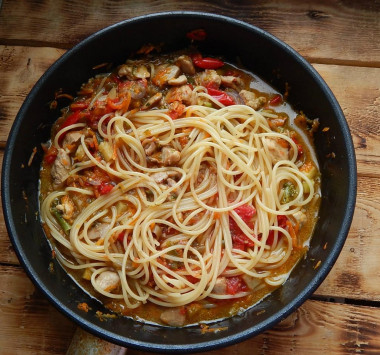
Stir. Try it on salt, add it to taste, mix. Leave the dish on the fire, literally for 2 minutes. Turn off the fire. Then serve the pasta with teriyaki sauce to the table.
Step 12:
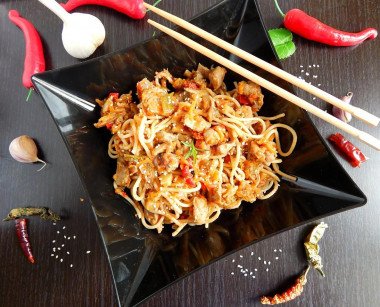
When serving, sprinkle the noodles with sesame seeds. Enjoy your meal!
Any oils are useful only until a certain temperature is reached - the point of smoking, at which the oil begins to burn and toxic substances, including carcinogens, are formed in it. How to determine the roasting temperature and choose the best oil for frying, and which is better not to use at all, read here .
Important! An incorrectly selected frying pan can ruin even the best recipe. All the details on how to choose the perfect frying pan for different dishes read here .
Since the degree of salinity, sweetness, bitterness, sharpness, acid, burning is individual for everyone, always add spices, spices and seasonings, focusing on your taste! If you put some of the seasonings for the first time, then keep in mind that there are spices that it is especially important not to shift (for example, chili pepper).
Caloric content of the products possible in the composition of the dish
- Tomatoes - 23 kcal/100g
- Sweet pepper - 27 kcal/100g
- Carrots - 33 kcal/100g
- Dried carrots - 275 kcal/100g
- Boiled carrots - 25 kcal/100g
- Eggplant - 24 kcal/100g
- Pasta, premium, fortified - 337 kcal/100g
- Pasta, premium, dairy - 309 kcal/100g
- Pasta, premium grade, egg - 342 kcal/100g
- Pasta made from flour of the 1st grade - 333 kcal/100g
- Pasta made of flour in / with - 338 kcal/100g
- Boiled pasta - 135 kcal/100g
- Pasta - 338 kcal/100g
- Garlic - 143 kcal/100g
- Vegetable oil - 873 kcal/100g
- Dried whole sesame seeds - 563 kcal/100g
- Shelled sesame seed - 582 kcal/100g
- Salt - 0 kcal/100g
- Onion - 41 kcal/100g
- Fresh frozen soup greens in a package - 41 kcal/100g
- Greenery - 41 kcal/100g
- Chicken breast (fillet) - 113 kcal/100g
- Ground pepper mixture - 255 kcal/100g
- Teriyaki sauce - 89 kcal/100g

